Color of Light Best for Growing Tomatos

Look for full spectrum bulbs with a mix of cool and warm wavelengths.
If you're trying to grow houseplants indoors, you'll find that some rooms of your house are low in natural light. Sunlight is the perfect balance of wavelengths necessary for plant growth and blooming, but you can also use artificial light to help your plants along. In fact, low-light foliage plants (such as pothos and peace lily) can grow quite nicely in windowless offices with enough artificial light.
In order to grow, plants need:
- Blue wavelength light for foliage growth.
- Red wavelength light for flowering and fruiting.
- Plants have little use for green wavelengths and reflect them back, which is why leaves appear green.

Replace regular bulbs with CFLs to save energy and help your houseplants.
Types of Artificial Lights
For serious indoor growing and starting plants from seeds, you'll need hanging tube fixtures placed right over your plants. You can buy special grow light kits that include fixtures and reflectors, but for regular houseplants you can really use any lamp or light fixture as long as you choose the bulbs carefully and place the lamps where your plants can benefit most.
Artificial lighting:
- Fluorescent lights are by far the most economical and easy choice for houseplants. They come in tubes or compact bulbs (CFL) that screw into regular lamp sockets, and they're cool enough to put close to plant foliage. Generic fluorescent tubes and bulbs are higher in blue wavelengths, so look for "full-spectrum" or include a mix of "cool" and "warm" bulbs. When in doubt, buy "cool white" products, since white light contains the full spectrum of wavelengths. For maximum effect, position fluorescents about a foot away from plant foliage.
- Incandescent lights give off a lot of heat and should be placed farther away from plant foliage. Incandescent bulbs give off more red wavelengths, so they can be used to supplement fluorescent light and balance out the spectrum, especially if you're trying to encourage plants to bloom. If you want to mix the two, try using a ratio of about one-third incandescent and two-thirds fluorescent by wattage.
- LED lights are also a low heat, energy-efficient artificial light source. Because LED technology is so customizable, every bulb is different, so make sure your bulbs produce the blues and reds necessary for plants. Horticultural LED grow-lights produce only the wavelengths most utilized by plants, so you may want to look for these bulbs rather than buying ones for general use.
- Halogen lights can also provide full-spectrum light, but like incandescents they put off a lot of heat and are less energy-efficient than fluorescents.
- Horticultural grow lights are generally packaged in tubes for fluorescent fixtures. They contain the full spectrum of wavelengths needed for blooming plants such as African violets. Some gardeners find them useful when starting seeds or propagating hybrids, but others find that simple full-spectrum fluorescents work just as well.


Lighting Tip
Beware of light bulbs simply labeled as "plant" bulbs, such as these "Spot-Gro" bulbs. They're designed to make your plants LOOK better by making them appear more green, but they're really just tinted incandescent bulbs.
Easy plant lighting for room with low natural light:
- Find a standing lamp with three bulbs, ideally one with moveable or gooseneck fixtures.
- Use one incandescent bulb and two compact fluorescent bulbs of the highest wattage you can, within the safe wattage rating for the fixture.
- Aim the lights toward your plant table. If each fixture is separately movable, then put the fluorescent bulbs closer than the incandescent, to avoid heat damage.
- Place a mirror or other reflective surface underneath your plants, to reflect light back up onto the foliage.
- Attach a timer set to 16 hours per day.
Further Information
- Lighting Indoor Houseplants (University of Missouri)
- How to Grow Houseplants in Low Light Conditions
- Beginner's Guide to Caring for Houseplants
Color of Light Best for Growing Tomatos
Source: https://todayshomeowner.com/how-to-grow-houseplants-in-artificial-light/